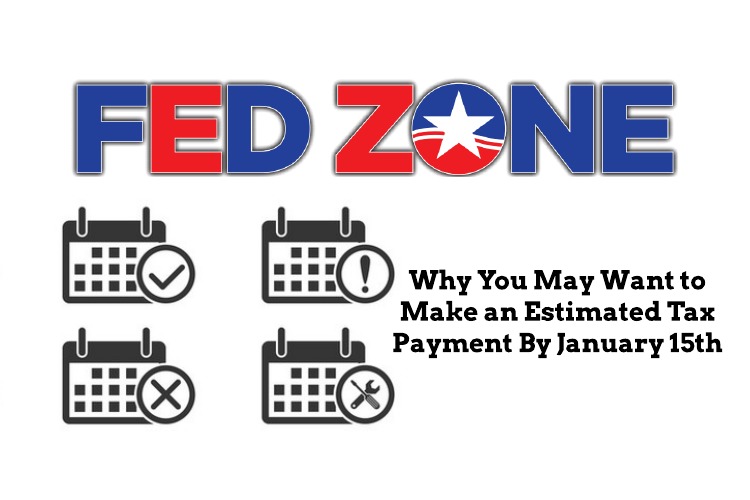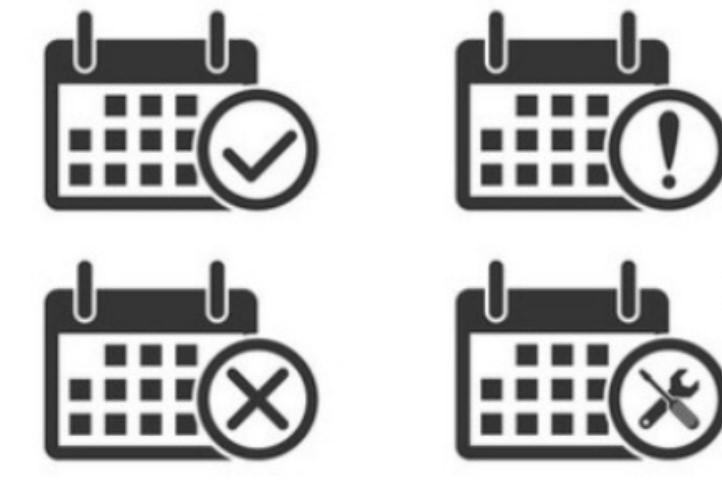Employees Who May Owe Significantly on Their 2020 Taxes Should Make An Estimated Tax Payment by January 15, 2021

Edward A. Zurndorfer
Federal employees have federal and state income taxes regularly withheld from their paychecks. But many employees receive income from other sources in which federal and state income taxes are not withheld. This income includes interest from banks, stock dividend and capital gains income from brokerage firms, rental income from rental property, gig economy earnings, self-employment income, and alimony. In order to pay the federal and any state income tax that all of this income is subject to, the employee must either have additional payroll tax withholding or make estimated tax payments to the IRS and to their state revenue department. This column discusses which Federal employees should make estimated tax payments to the IRS and to their state revenue departments.
The rationale behind individuals making estimated tax payments is simple. Both the IRS and state revenue departments prefer not to be paid a significantly large balance due when an individual files his or her federal or state income taxes in the spring following the end of the year the return is being filed for. With respect to having taxes withheld from one’s salary, the purpose of payroll tax withholding is for the wage earner to “pay (tax) as you earn”. But if an individual is the recipient during the year of a significant amount of taxable income in which there is no income tax withholding, the IRS and state revenue department prefer that the individual take the responsibility to pay the tax due on that income when that taxable income is earned. Ideally, theses tax payments should be made during the quarter of the year in which this taxable income was earned and received.
An example of no or insufficient state income tax withholding occurs when a federal employee moves from one state to another and fails to notify the payroll department of the correct amount of state income tax withholding, given the employee’s new legal state of residence. The employee may discover the insufficiency late in the year and has to make up for the insufficient state income tax withholding. This is accomplished by making state estimated tax payment.
Individual estimated tax payments are therefore used as a direct means of paying federal and state tax liabilities when regular income tax withholding is not possible.
Which Employees are Candidates to Make Estimated Tax Payments?
If an individual at the time of filing his or her current year federal income tax return expects to owe more than $1,000 in federal income taxes after subtracting current year tax federal income tax withholding and refundable credits, then the IRS recommends the individual pay estimated taxes. In the event the individual owes more than $1,000 upon filing his or her tax return, the IRS could impose what is called an “underwithholding” penalty. With respect to paying state estimated taxes, every state with an income tax has its own rules when it comes to paying estimated state income taxes. For example, the State of Maryland recommends that a state resident pay estimated taxes to the State of Maryland when the individual expects to owe more than $500 at the time of filing his or her current year Maryland income tax return. Individuals are advised to check with their state revenue departments in order to find out whether they need to pay estimated taxes to their states. The remainder of the column will focus on IRS rules regarding federal estimated tax payments.
The IRS offers “safe harbor” guidelines to help individuals avoid underwithholding penalties. One such “safe harbor” is that an individual will avoid an underwithholding penalty if the individual’s total federal income tax withholding (from salary, pensions, IRAs, Social Security benefits) is within 90 percent of the individual’s federal tax liability for the year. The following example illustrates:
Carol, a federal employee, had a total of $23,000 in federal income taxes withheld from her salary during 2020. Her expected 2020 federal tax liability is $24,000. Since 90 percent of $24,000 or $21,600 is less than $23,000, Carol meets the “safe harbor” guideline and will not be subject to an underwithholding penalty when she files her 2020 federal income tax return.
Another “safe harbor” is for an individual to have withheld through payroll deduction during the current an amount of federal income taxes that is equal to 100 percent of the previous year’s federal income tax liability. The “safe harbor” increases to 110 percent of the previous year’s federal tax liability if the individual’s adjusted gross income in the previous year was over $150,000. The following example illustrates:
Jerry, a federal employee had an adjusted gross income of $180,000 during 2019. His 2019 federal tax liability was $30,000. Jerry’s 2020 federal tax withholding totaled $35,000. Since Jerry’s total 2020 federal tax withholding of $35,000 exceeds 110 percent of Jerry’s 2019 federal tax liability (110 percent of $30,000 or $33,000), Jerry meets the “safe harbor” guideline and will not be subject to an underwithholding penalty when he files his 2020 federal income tax return.
An individual is not subject to a federal underwithholding penalty if: (1) the individual’s federal tax liability when current years are filed is less than $1,000; and (2) the individual was a U.S. citizen or resident and had no tax liability on the pervious year’s return that covered 12 months.
How to Pay Estimated Taxes
The IRS would prefer that individuals pay their estimated taxes in four equal payments over the course of the year. However, when an individual is the recipient of a large amount of taxable income (not subject to withholding) at some point during the year, the individual should make an estimated tax payment for the quarter in which the taxable income was received. The following table summarizes the estimated tax payment due dates for 2020 and 2021:
| Installment | Covering which period | 2020 Estimated Tax Payment Due Dates | 2021 Estimated Tax Payment Due Dates |
| 1 | Jan. 1– Mar. 31 | April 15, 20201 | April 15, 2021 |
| 2 | Apr. 1- May 31 | June 15, 20201 | June 15, 2021 |
| 3 | June 1 – Aug. 31 | September 15, 2020 | September 15, 2021 |
| 4 | Sept. 1 – Dec. 31 | January 15, 2021 | January 18, 2022 |
The following example illustrates: Frank sold his beach vacation home in August 2020 and netted a profit of $80,000. He owes federal income tax of $12,000 (15 percent times $80,000). Frank should have made a federal estimated tax payment equal to at least 90 percent of $12,000, or $10,800. Because Frank sold the home in August 2020, he should have made his estimated tax payment by Sept. 15, 2020. If Frank did not make the September 15, 2020 payment, then he should still make the payment even if it will be made after the due date.
What Should Employees who may Owe More than $1,000 in Federal Taxes Do Before January 15, 2021?
Those employees who think they will owe more than $1,000 in federal income taxes when they file their 2020 federal income taxes in spring 2021 are advised to make a 2020 estimated tax payment due Jan. 15, 2021. Here are the steps that should be performed:
Step 1. Estimate 2020 total income including salary income (look at the last leave and earnings statement (LES)) for the final pay date of 2020 which will show the 2020 cumulative salary and federal income taxes withheld. Also check year-end bank and brokerage statements showing cumulative investment income including interest dividends and capital gains. If receiving any pension or IRA income, look at year-end statement to include total income received for the year as well as cumulative federal income taxes withheld.
Step 2. Total federal income tax withholding from salary and pension/IRA income, and any federal estimated payments previously made during 2020.
Step 3. Do a rough estimate of 2020 tax liability from the information in Step 1. If the amount of 2020 taxable income computed in Step 1 is approximately the same as one’s 2019 taxable income (and there was more than $1,000 balance due was paid when 2019 federal income taxes were filed in 2020), use the 2019 federal tax liability to determine how much of an estimated tax payment has to be made for 2020. If the amount of 2020 taxable income computed in Step 1 at least 10 percent less than 2019 taxable income, use 90 percent of the approximate 2020 federal tax liability to determine how much of an estimated tax payment has to be made.
Step 4. If total income in Step 1 is over $150,000, then use 110 percent of one’s 2019 federal tax liability to determine how much of an estimated tax payment has to be made for 2020.
Step 5. Depending on one’s situation, subtract the amount in Step 2 from the amount in Step 3 or from the amount in Step 4.
Step 6. If the amount in Step 5 is more than $1,000, an estimated tax payment due January 15, 2021 should be made.
Additional information including a federal estimated tax worksheet may be found here. The worksheet also includes a 4th quarter 2020 federal estimated tax payment voucher that is included when making the payment. The IRS will accept one’s payment in any number of ways. Instructions for payment options can be found here.
Employees who have any additional questions about making a 2020 estimated tax payment are encouraged to contact a tax professional as soon as possible. This is also important with regard to making a state estimated tax payment, in which the deadline for making the 4th quarter state estimated tax payment for 2020 is also January 15, 2021.
You Might Also Enjoy This Podcast:
Edward A. Zurndorfer is a CERTIFIED FINANCIAL PLANNER™ professional, Chartered Life Underwriter, Chartered Financial Consultant, Chartered Federal Employee Benefits Consultant, Certified Employees Benefits Specialist and IRS Enrolled Agent in Silver Spring, MD. Tax planning, Federal employee benefits, retirement and insurance consulting services offered through EZ Accounting and Financial Services, and EZ Federal Benefits Seminars, located at 833 Bromley Street – Suite A, Silver Spring, MD 20902-3019 and telephone number 301-681-1652. Raymond James is not affiliated with and does not endorse the opinions or services of Edward A. Zurndorfer or EZ Accounting and Financial Services. The information has been obtained from sources considered to be reliable, but we do not guarantee that the foregoing material is accurate or complete. While we are familiar with the tax provisions of the issues presented herein, as Financial Advisors of RJFS, we are not qualified to render advice on tax or legal matters. You should discuss tax or legal matters with the appropriate professional.

